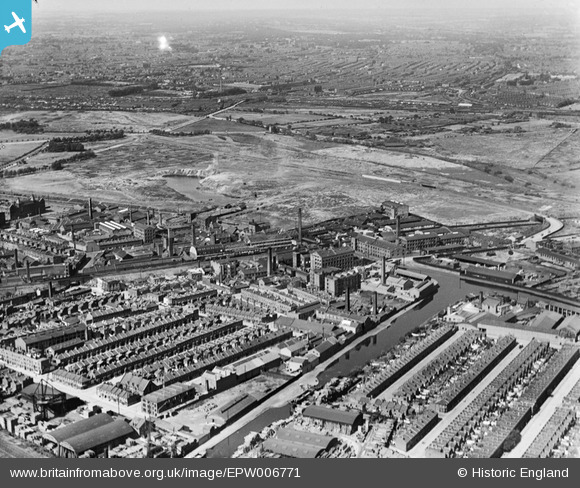EPW006771 ENGLAND (1921). The Clarnico Works, Bow, from the south-west, 1921
© Hawlfraint cyfranwyr OpenStreetMap a thrwyddedwyd gan yr OpenStreetMap Foundation. 2025. Trwyddedir y gartograffeg fel CC BY-SA.
Delweddau cyfagos (12)
Manylion
| Pennawd | [EPW006771] The Clarnico Works, Bow, from the south-west, 1921 |
| Cyfeirnod | EPW006771 |
| Dyddiad | June-1921 |
| Dolen | |
| Enw lle | BOW |
| Plwyf | |
| Ardal | |
| Gwlad | ENGLAND |
| Dwyreiniad / Gogleddiad | 537129, 184397 |
| Hydred / Lledred | -0.022373867404279, 51.54131138159 |
| Cyfeirnod Grid Cenedlaethol | TQ371844 |
Pinnau

Hermann the German |
Sunday 20th of October 2013 06:52:27 PM | |

Chelsea61 |
Wednesday 5th of June 2013 10:34:25 PM | |

POBus |
Tuesday 28th of August 2012 07:23:42 PM | |

POBus |
Tuesday 28th of August 2012 07:18:27 PM | |

POBus |
Tuesday 28th of August 2012 07:18:07 PM |
Cyfraniadau Grŵp
This comment is coming late on the scene for this image, anyhow, I wouldn't tag this as "Bow" at all. It sits on White Post Lane, and whilst true it is within the borough of Tower Hamlets, the colloquial name for the area is still 'Hackney Wick'. Bow proper, so to speak is some one mile further south. |
 8-2007.JPG)
Keith |
Thursday 12th of February 2015 07:46:22 PM |
Astonishing to see such a valuable image when you consider how much the 2012 games has 'improved' the area in the last 5 years. Using 006771 as base comment, the Hertford Cut canal approaches the River Lea Navigation Cut from the bottom of the picture. The last remnants of the Clarnico Works was still standing in 2004 and it was possible to capture a photo which related to an heroic deed of PC (William) George Hack, G.M. 1940. See below. Just to the right of the works is an unfinished section of highway (white) and this will be Waterden Road when completed.The gravel pit further left could so easily have been the later site of the Hackney Greyhound Stadium also in Waterden Road. If you zoom to the northern most part of the image it depicts the then existing roads from Left, Homerton Road joining Ruckholt Road which is picked out with a perfect tree-lined border, and running away to the top as it crosses the railway (Temple Mills Marshalling Yards - then the largest such site in Europe). You may be able to see the 'triangular' set of roads which are to right before the railway bridge. This was Quartermile Lane and Temple Mills Lane which ran to the right alongside the famous Eton Manor Sports Ground (created by Major James Villiers)before joining Crownfield Road. All usurped now by the Olympic sites and public access to roam forbidden until well into 2013! The Eton Manor site itself has been totally ruined with all the football pitches(6), 2 rugby ones, and two cricket squares, not to mention over 60 mature trees, all felled to make way for "temporary" stadia. Yet during the 50's to 1970's many of GB's past champions, including my own favourite, the late Lillian Board, cut their teeth on the old cinder track in amateur floodlit league matches. There is one singular building just close to the triangle of roads, this is the White Hart P.H. which stood until 1994, and was the earliest casualty of the plans to construct the M11 Link Road from the Lea Interchange to Leytonstone Green Man and beyond to Wanstead. I am loading up a current view of the Carpenter's Road bridge which shows one remaining Clarnico building extant. It was just beyond this under the bridge and adjacent to the river, that PC Hack came upon part of a collapsed building due to a German air raid in 1940. WHat made things worse was the fact he could hear people calling for help as they had been trapped in a works air-raid shelter, and the river outside was gradually seeping through to the below ground shelter. He alone managed to extracate all 6 people and get them to safety, whilst all the time, more bombs were falling. Soon after, he also assisted two other officers who were dealing seperately to get a seventh person out from under another building nearby. PC Hack - 'J' Division was awarded the George Medal: citation London Gazette p6610 15 Nov 1940. Much of the additional information was retold to me by a former colleague of George's in 'J' Divn, the late Les Clabon. |
 8-2007.JPG)
Keith |
Sunday 1st of July 2012 07:26:16 PM |
Wow Keith so much amazing info! It's great being able to see these early photos of places which have changed so much. |

Whittocks |
Sunday 1st of July 2012 07:26:16 PM |


![[EPW006771] The Clarnico Works, Bow, from the south-west, 1921](http://britainfromabove.org.uk/sites/all/libraries/aerofilms-images/public/100x100/EPW/006/EPW006771.jpg)
![[EPW006770] The Clarnico Works, Bow, 1921](http://britainfromabove.org.uk/sites/all/libraries/aerofilms-images/public/100x100/EPW/006/EPW006770.jpg)
![[EAW022429] The J. Gliksten and Son Ltd timber yard on Carpenter's Road and environs, Old Ford, from the west, 1949. This image has been produced from a print marked by Aerofilms Ltd for photo editing.](http://britainfromabove.org.uk/sites/all/libraries/aerofilms-images/public/100x100/EAW/022/EAW022429.jpg)
![[EPW006773] The Clarnico Works, Hackney Wick, 1921](http://britainfromabove.org.uk/sites/all/libraries/aerofilms-images/public/100x100/EPW/006/EPW006773.jpg)
![[EAW022430] The J. Gliksten and Son Ltd timber yard on Carpenter's Road and environs, Old Ford, 1949. This image has been produced from a print marked by Aerofilms Ltd for photo editing.](http://britainfromabove.org.uk/sites/all/libraries/aerofilms-images/public/100x100/EAW/022/EAW022430.jpg)
![[EPW006777] The Clarnico Works, Bow, 1921](http://britainfromabove.org.uk/sites/all/libraries/aerofilms-images/public/100x100/EPW/006/EPW006777.jpg)
![[EPW006776] The Clarnico Works, Bow, 1921](http://britainfromabove.org.uk/sites/all/libraries/aerofilms-images/public/100x100/EPW/006/EPW006776.jpg)
![[EPW006774] The Clarnico Works, Hackney Wick, 1921](http://britainfromabove.org.uk/sites/all/libraries/aerofilms-images/public/100x100/EPW/006/EPW006774.jpg)
![[EPW006775] The Clarnico Works, Hackney Wick, 1921](http://britainfromabove.org.uk/sites/all/libraries/aerofilms-images/public/100x100/EPW/006/EPW006775.jpg)
![[EPW006772] The Clarnico Works, Hackney Wick, 1921](http://britainfromabove.org.uk/sites/all/libraries/aerofilms-images/public/100x100/EPW/006/EPW006772.jpg)
![[EPW011914] Clarke, Nicholls and Coombs Ltd Clarnico Works beside the Hackney Navigation, Hackney Wick, 1924. This image has been produced from a copy-negative.](http://britainfromabove.org.uk/sites/all/libraries/aerofilms-images/public/100x100/EPW/011/EPW011914.jpg)
![[EPW009966] Timber yards beside the Hackney Cut Navigation, Bow, 1924](http://britainfromabove.org.uk/sites/all/libraries/aerofilms-images/public/100x100/EPW/009/EPW009966.jpg)